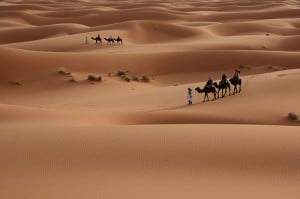 Hollywood films have tried to encapsulate the immensity of the Sahara Desert in several genres from action/adventure to romantic tales, but it’s really one of those sites that you have to see to believe. Whether you are traveling for a vacation in Morocco or just want to know a bit more about one of the world’s most interesting deserts, here are just a few grains of information you might find interesting:
Hollywood films have tried to encapsulate the immensity of the Sahara Desert in several genres from action/adventure to romantic tales, but it’s really one of those sites that you have to see to believe. Whether you are traveling for a vacation in Morocco or just want to know a bit more about one of the world’s most interesting deserts, here are just a few grains of information you might find interesting:
Sizing Up the Sahara Desert:
The Sahara Desert is 3.63 million square miles (9.4 million square kilometers). It runs from the Red Sea to the Mediterranean Sea and Atlantic Ocean and into central and western Africa. The desert covers parts of Morocco, Algeria, Egypt, Chad, Libya, Mali, Niger, Mauritania, Western Sahara, Tunisia and Sudan.
Morocco is 172,402 square miles (446,519 square kilometers), but only a portion of this land mass is part of the Sahara Desert. There is a controversy over the Western Sahara in that most Moroccans will tell you it belongs to their country, but the United Nations does not agree. Few outside of Morocco will actually agree that the Western Sahara belongs to Morocco. Due to the disputes, there is no accurate notation for how many square miles of the Sahara Desert are in Morocco.
The Desert Dwellers:
Geologically, the Sahara Desert is 3 million years or older; however, it was first settled in 9500 BC. During this Neolithic period, Nubians, in what is now Central Sudan, lived off the rich environment that used to exist.
The Egyptians were next to settle around the Nile Valley. They were able to survive until 3400 BC, when the desert became as dry as it is today. Facts suggest the Berbers have been in the desert since before the 7th century, which makes this culture one of the oldest in the Sahara. They remained even as the Phoenicians, Greeks, Romans, Spanish and French all moved on. Today, those who live in the Sahara Desert are Berber and Tuareg nomads. Humans occupy about two- thirds of the desert.
The lack of any true urbanization leaves area open to various animals and plants. Camels and goats are two domesticated animals of the desert. They are used by nomads for transportation and food, respectively. Insects, such as the deathstalker scorpion are hardy species, capable of living in the desert with little food or water. Monitor lizards, horned vipers, sand vipers, and skinks are among the oldest species to live in the Sahara.
Phoenix pterosaur is the most recent dinosaur to be found in the Sahara Desert by paleontologists. The pterosaur, also known as a pterodactyl, lived 95 million years ago. They call these new bones the Phoenix because they rose out of the sand almost like the mythical creature born of fiery ashes. From the discovery, scientists can tell its wing span was easily 19.7 feet.
The Saharan Climate:
It is hard not to talk about climate when mentioning those who live in the Sahara Desert. The land is dry and arid, which makes it difficult to live there. Geological research has found that wet and dry periods—even a glacial period—existed at some time in the desert’s history. From 8000 BC to 6000 BC, ice sheets melted away from a hot rain. Eventually the rain became less frequent, and the desert took on the characteristics it has today.
Visitors to Morocco will find temperatures ranging from 34 degrees to 108 degrees Fahrenheit. In winter, temperatures drop, nights become bitterly cold and days are more tolerable. Summer requires acclimation and proper clothing for the extreme heat. Fall and spring are milder, but sunscreen is still a must.
Few plants are able to survive Saharan temperatures, but the monsoon season helps grasses, shrubs, and trees grow. The plants are in the xerophytes and halophytes designation, meaning they require little water with soil rich in salts. The African peyote cactus is one of the more hardy plants of the desert.
November through March marks the rainy season, and monsoons are possible. March to April is when sandstorms are most likely to occur. It is the sandstorms that form the dunes and eat away at rock formations.
Written by Sam Mitchell.
Photo by alex lichtenberger.









I luv Mattew K he is sooooo fit and funny did youn know he has been to the sahara dessert